Battle of the Titans (long-lived smartphones): innos D6000 (6000 mAh) vs. Oukitel K10000 (10,000 mAh)
Hello! The innos blog on geektimes.ru has a number of articles on the innos brand in general and the innos D6000 smartphone in particular. For example, you can read a detailed review of this model, a comparison of innos D6000 with its counterparts and competitors - other popular models with powerful batteries, a story about the history of innos and the first activity reportbrand in the Russian market. Of course, I analyzed all your comments on the above publications. And I noticed that several readers immediately reminded about the existence of the Oukitel K10000, a smartphone with the most powerful battery - as much as 10,000 mAh. Like, 6,000 mAh for the innos D6000 is, of course, great, but there are cooler devices in terms of battery life. Some commentators proposed to compare innos D6000 with Oukitel K10000 - and not without a “black” irony, as if hinting that the innos model would “merge” the competitor in all respects.

Well, you asked - we do. For two weeks I used the Oukitel K10000 and innos D6000 at the same time, the result of which is this comparative review. For the sake of order, let me remind you that we absolutely confidently call the innos D6000 “the most thoughtful long-lived smartphone” - and in this post I will once again explain what is meant by this, so to speak, term. Because in Oukitel they didn’t think of almost anything, but simply took some kind of apparatus - apparently, the developers initially planned to create a Vertu clone - and, in a hurry, inserted the largest battery they could find. What was the result? It turned out, to put it mildly, something strange. But more on that below, but for now - a comparative table:

Of course, an unprepared user Oukitel K10000 makes a serious impression. As mentioned above, some might think that this is a new Vertu for a few thousand dollars. This is indeed possible, given that there are no inscriptions and logos on the front panel of the device hinting at Oukitel. However, all positive in a moment is destroyed when this very unprepared user picks up a device, for example, off the table. It has 317 (three hundred and seventeen) grams of live weight! And bare slippery metal on the sides! To be honest, such a heavy construction, and even with an unpleasant feature in the form of slipperiness, makes the model unsuitable not only for women, but also for some men. Perhaps some readers have come across so-called protected Android smartphones - like the teXet X-Driver; So, the Oukitel K10000 is even more massive and heavier, although there is no protection here.

The body - and you can’t argue with that - is made to last, the build quality is excellent. Metal panels, however, do not look very cool. Neither the iPhone, nor the Samsung Galaxy will not see such here ... well, color drops, or something. Perhaps this is such a feature (defect?) Of metal processing.
The central part of the back panel bears on itself a black plate - apparently, it is also a thin metal. The logo with the bull looks cool, as well as, by the way, screws, “scattered” throughout the body. In general, the design of the model will not stick to it - he is really quite cute. And brutal.
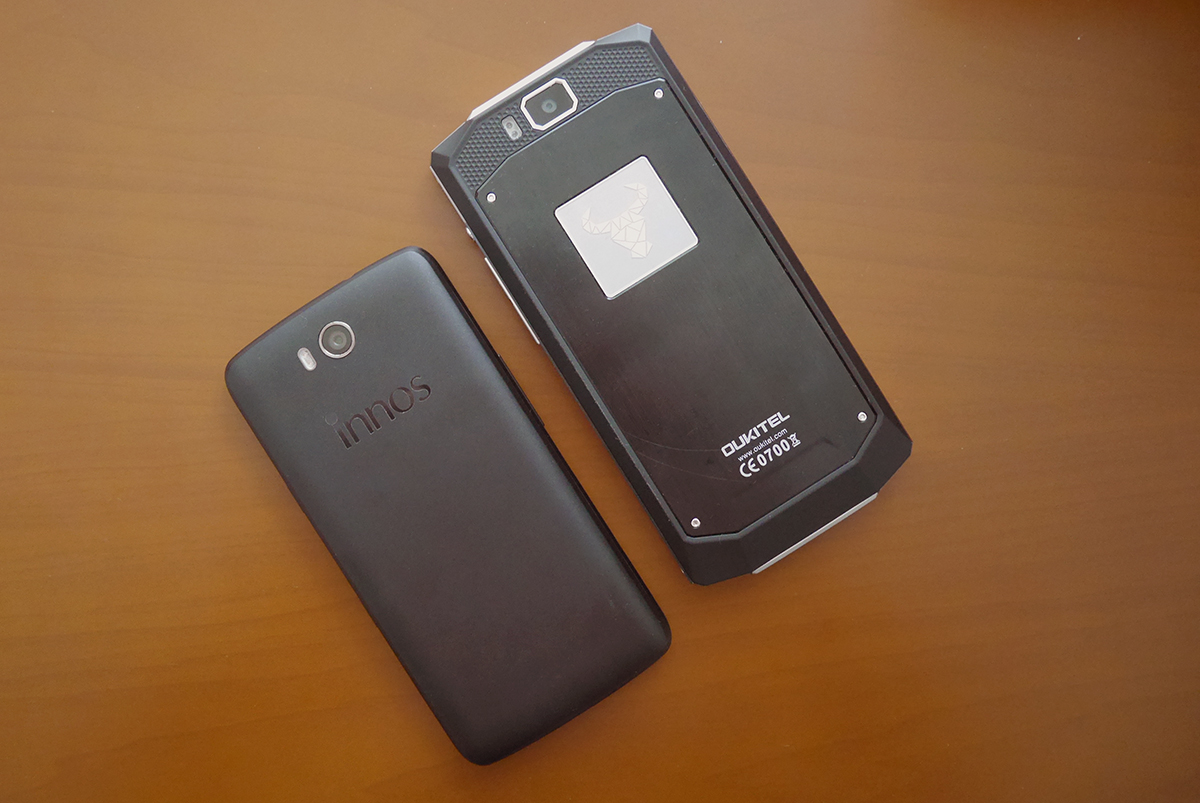
innos D6000, of course, on the background of the Oukitel K10000 looks inconspicuous. No frills here, just black polycarbonate on the sides and back. The material is rough, so that in the hand innos D6000 is not bad. With its 188 grams of weight, he looks like a feather after the Oukitel K10000. And also innos D6000 is perceived as a rather elegant thing: its thickness is 12 mm versus 14 mm in Oukitel K10000. It would seem a trifle, but when you try to cram a smartphone into your jeans pocket, even 2 mm play a role. Innos D6000 is also assembled perfectly - there are no creaks, the device is monolithic, although it has a collapsible design.
The Oukitel K10000 has inserts from a material that looks like rubber. Ideally, rough tires would be very useful here - after all, the sidewall is slippery! She could "cling" to her hand, helping to hold a smartphone in her. But no, alas, it is not rubber, but such plastic. And quite slippery. So to operate the Oukitel K10000 is really not that simple. And to drop it is scary: if such a metal object is, for example, on a toe, then a trip to the emergency room cannot be avoided.

The same plastic that resembles rubber
Multimedia speakers in both smartphones are located on the bottom of the case, this is convenient, since the sound does not overlap, no matter how the smartphone is lying - even if it is “face on the floor”, on the contrary. The Oukitel K10000 has two speakers, but the sound is rather dirty, so cheap Chinese speakers usually play at 500 rubles each. Innos D6000 has only one speaker, but it “sings” more qualitatively and loudly. At the same time, the volume of percent is 20 higher for the Oukitel K10000.
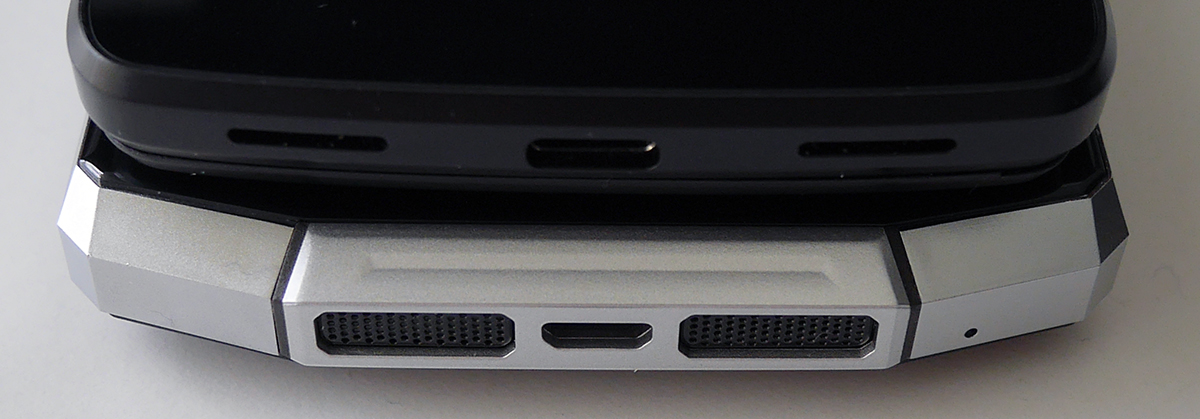
The Oukitel K10000 uses a microUSB port, and is very heavily recessed into the case. This means that charging it anyhow with what kind of cable will not work - it comes with a cord with a special long plug. That is, it is about 2 mm longer than the cables supplied, for example, with Samsung smartphones. Cords from the latter with the Oukitel K10000 do not work - there is not enough plug length. So if you please use the complete! Reasonableness, versatility, convenience? No, not heard.
This is to the question that innos D6000 uses USB Type-C, which is convenient at least due to its symmetry. Many people like to write in the comments that, they say, "at my work / at my wife / in the car / at home / at the dacha cable with a MicroUSB, and then I have to carry USB Type-C everywhere." First, such a cable can be purchased on innos.com/rufor 590 rubles. Secondly, with the Oukitel K10000, you also have to carry a complete cable, and this will be an archaic and inconvenient MicroUSB, which, you see, is doubly unpleasant.

Cable connectors Oukitel K10000, a conventional microUSB cable (in this case, Samsung) and innos D6000. As you can see, the plug from the Oukitel K10000 is noticeably longer than usual!
The microphone at the Oukitel K10000 is also located on the bottom of the case, and it is only one. Innos D6000 has two microphones - one from the bottom (disguised as a second speaker), the second from the top. Due to this, a noise reduction system is formed - and it really works. In any case, the quality of voice transmission is noticeably higher in the innos D6000. There are no crunches, gurgles, and so on, but they are sometimes found in the Oukitel K10000. In this case, I emphasize that the latter unit also provides a satisfactory communication quality. Simply, it is slightly lower than the innos D6000.
Above the screens are light and proximity sensors, front cameras and conversational speakers. In the innos D6000, an LED indicator is added to this basic set, which notifies of various events (mail, PMs, missed calls) with orange light.

On the upper edges are standard 3.5 mm headphone jacks. The innos D6000 also has the second microphone mentioned above.
The standard Android control keys for the Oukitel K10000 are under the screen, and I have several complaints about them at once. First, I did not like the lack of illumination - in the dark they have to be searched by touch. Secondly, the icons are applied in a very peculiar way, like in many Chinese devices. Namely: the icon, indicating on all modern devices (the same Samsung Galaxy S7, for example, as well as many others) calling the most recently launched applications, in the case of the Oukitel K10000, calls up the context menu of properties, if provided in the application. And the last running ones can be displayed on the screen by pressing the home button. There are no such keys in innos D6000, more precisely, they exist, but in the virtual version - with the display on the screen. Personally, to me, to be honest, my heart is the third option: physical buttons, but with backlighting and normal symbols.

Other control keys are on the right side of the Oukitel K10000 case. Above the round small power button, below - volume control. Before the power key, given the 5.5-inch smartphone form factor, it is very inconvenient to reach for. In part, this problem is solved by the gesture-management application built into the firmware — for example, you can wake up the smartphone by double tapping the screen, unlock it by means of a horizontal pass, turn on the camera from a locked state with a horizontal pass, and so on. Everything would be fine, but this “gesticulation” works rather slowly. Before the action is performed (for example, the screen is unlocked), the smartphone shows an animation that takes a second and a half. Why it is necessary is not entirely clear, but it cannot be disabled.
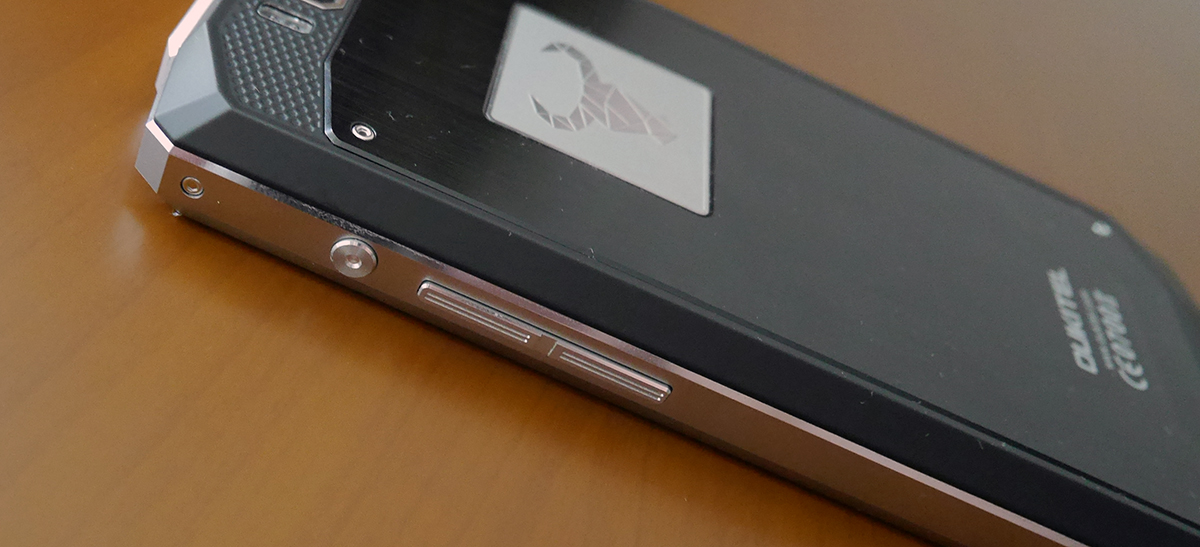


On the left - a list of gestures, on the right - a screenshot of the animation when unlocking with a horizontal pass.
The innos D6000 is more familiar. Volume control is located on the left, which is, let's say, more traditional. The power button, located on the right, does not have to stretch, the device is noticeably shorter than the Oukitel K10000. At the same time, an additional hardware button is provided in the innos D6000, on which any application can be hung - be it a VKontakte client or a screenshot. In the Camera application, she is always responsible for creating the snapshot. The button does not work when the device is locked (unless it turns on the screen), but still this is a very nice feature found in smartphones extremely rarely.



Application selection interface for the innos D6000 extra key
The back panel of the Oukitel K10000 is non-removable, that is, the device is not collapsible. Slots for "simok" and memory cards are on the side. To remove them is a clip that is included in the package. In my case, it was bent - whether it was an accident, or an indicator of "high" quality ...

However, personally I was not more upset by this, but by the construction of slots combined in a strange Chinese fashion. That is, either nano-SIM + nano-SIM, or nano-SIM + MicroSD. Well, OK, I still understand, when in this way they save space in ultra-thin models, but why did it happen here? With such a huge body? There would be five slots, not to mention three.

Innos D6000 slots are just three - two microSIM and one MicroSD. The back cover is removable, under it there is a removable battery of 3,520 mAh. Another one is built into the case - by 2 480 mAh. It is not visible, it is inside. Total battery capacity - 6,000 mAh. Removable battery can be removed without turning off the smartphone, that is, supported hot swap "on the fly." This is a unique feature of nnos D6000. Hot-swappable without turning off the device no one else has a smartphone in the world.
"External" batteries for innos D6000 can be bought as much as you like at innos.com/ru990 rubles each. Actually, if you buy only one such battery, then we get the total capacity of 9,520 mAh (6,000 + 3,520), which is almost the same as the Oukitel K10000. However, the story of the batteries and battery life will be left for a sweet - we'll talk about all of this below.
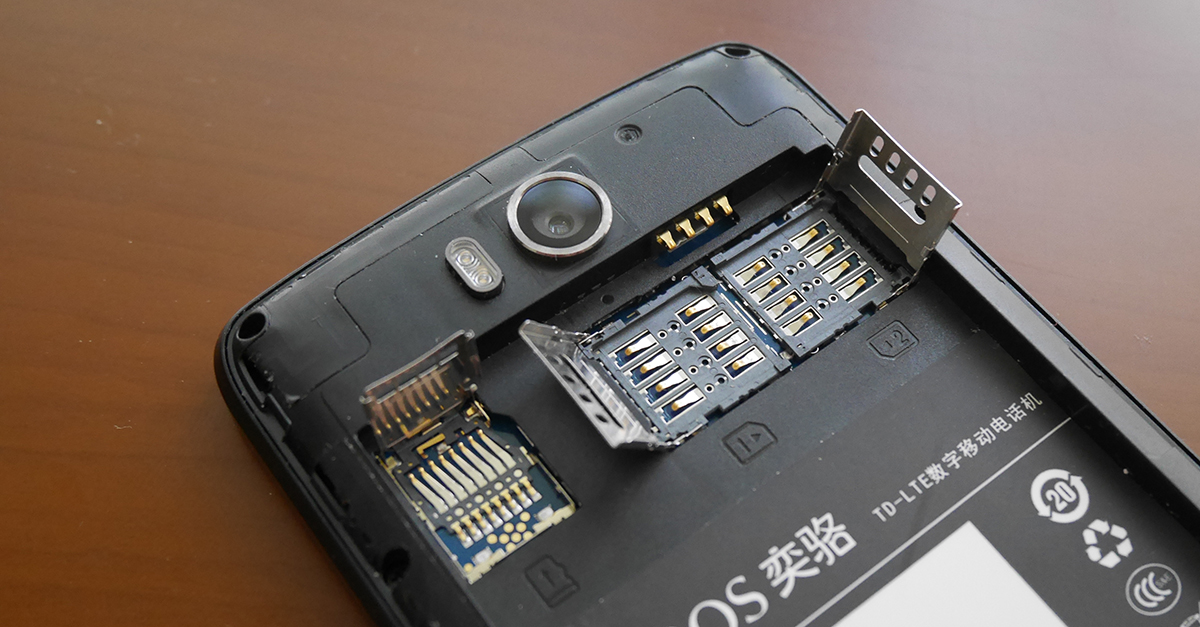
At Oukitel K10000 IPS-screen with a diagonal of 5.5 inches and a resolution of 1280 x 720 pixels. Not enough for such a diagonal, but the problem is not even in the grain of the picture (although it has a place to be). The problem is that it has an air gap between the glass and the matrix, and the backlight does not work evenly - just look at these lights at the bottom of the screen. Cherry on the cake are narrow viewing angles, despite the IPS-matrix, - with the deviation of the device, the image significantly loses contrast.
All this means that the Oukitel K10000 is equipped with a screen of previous generations, which not only shows a very average quality picture, but also has a higher power consumption compared to modern displays. The only advantage of this screen is a large margin of brightness.
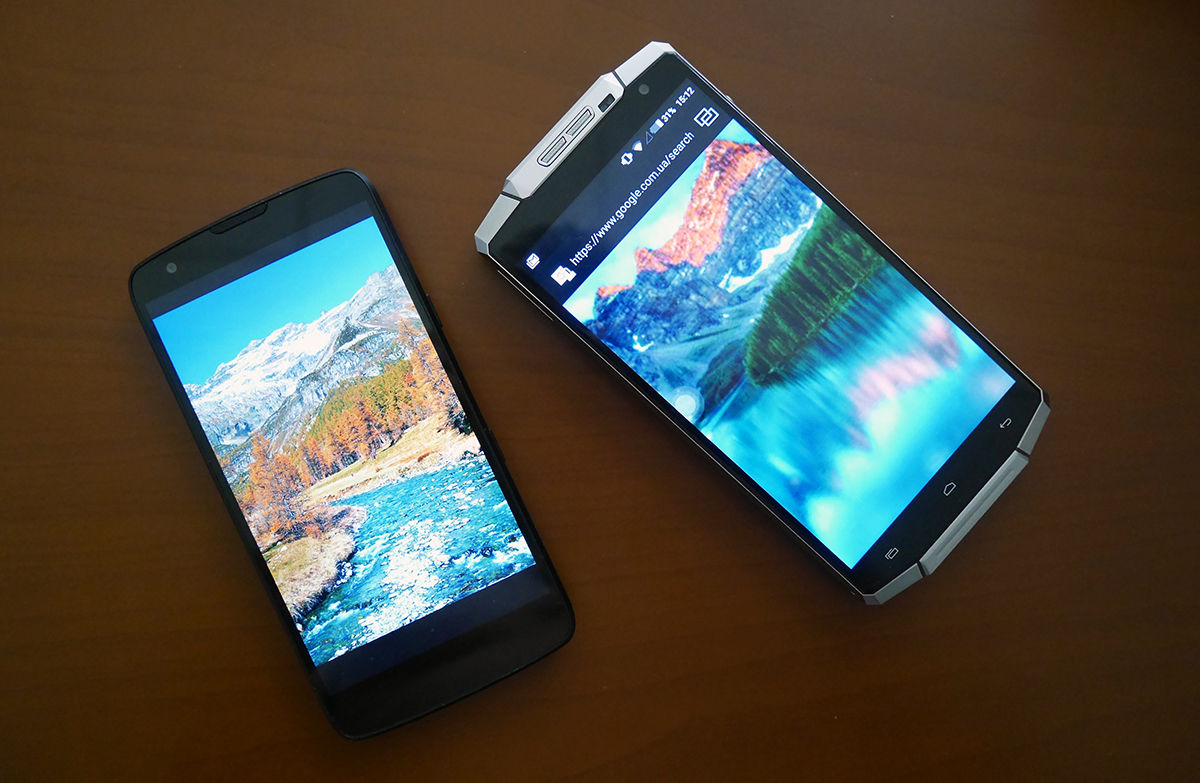
Innos D6000, on the other hand, has a completely modern IPS screen from Japan Display with OGS (when there is no air gap) and even backlighting without any spots and other artifacts. The display resolution is 1920 x 1080 pixels with a diagonal of 5.2 inches. It is difficult to say which screen eats more energy, given the different diagonals and resolution. Most likely, they are about the same in this regard. But the fact is that the innos D6000 display displays a much better picture - this also applies to clarity, and viewing angles, and the purity of black, and behavior in the sun.
The sensitivity of the touchscreen is the same - there are no problems with the management of both smartphones. That's just the grease-repellent coating in the Oukitel K10000 is missing, it collects fingerprints quickly enough. Innos model has such coverage, and there are virtually no problems with prints. Yes, here I will add that the screens in both cases are covered with Gorilla Glass 3 glass.
The innos D6000 uses a Qualcomm Snapdragon 615 chipset with an 8-core processor. This is a special case of the ARM big.LITTLE architecture - 4 Cortex-A53 cores here can accelerate to 1.5 GHz, and another 4 cores (also Cortex-A53) - to 1.1 GHz. All this works together with 3 GB of RAM LPDDR3. Actually, the reasonableness of innos D6000 lies in the choice of such a chipset. It is sufficient (although not maximally) economical, but at the same time provides a high speed of the device and more than sufficient performance in toys with 3D graphics. The ARM big.LITTLE architecture, again, helps: if the device is not loaded with any specific serious tasks, then inactive cores are disabled for the sake of saving energy. In general, the speed of the innos D6000 there are no complaints - and in any mode, whether it be games or web browsing with a dozen open tabs. I read that some people consider the Snapdragon 615 "not productive enough." I do not know who took this statement and where. Perhaps, someone was “lucky enough” to work with the device, which had a raw firmware. Well, or in his smartphone on the Snapdragon 615 was 1-2 GB of RAM - against 3 GB innos D6000.


Everything is interesting with the Oukitel K10000. The device uses a bundle of 2 GB of LPDDR3 RAM and a MediaTek MT6735P chipset, that is, the simplest version with 4 Cortex-A53 cores (up to 1 GHz) and Mali-T720MP2 graphics accelerating to 400 MHz. MediaTek does not have information about this version of the chipset, but some sourcesreported that her lot - screens with a resolution of 540 x 960 pixels (!). For comparison, the MT6735M with a graphics accelerator frequency of 500 MHz can work with HD displays (1280 x 720), and the MT6735 with a graphics frequency of 600 MHz and 1.3 GHz processing cores with Full HD screens (1920 x 1080) . The Oukitel K10000, as you already know, is worth the MT6735P and ... HD display. That is, this chipset for this resolution is not sharpened, but the developers of the smartphone for some reason chose the version of the platform with the letter “P” in the title. How it can affect the stability and speed of the smartphone, its power consumption, and so on - guess yourself. (Answer: obviously not positive.)
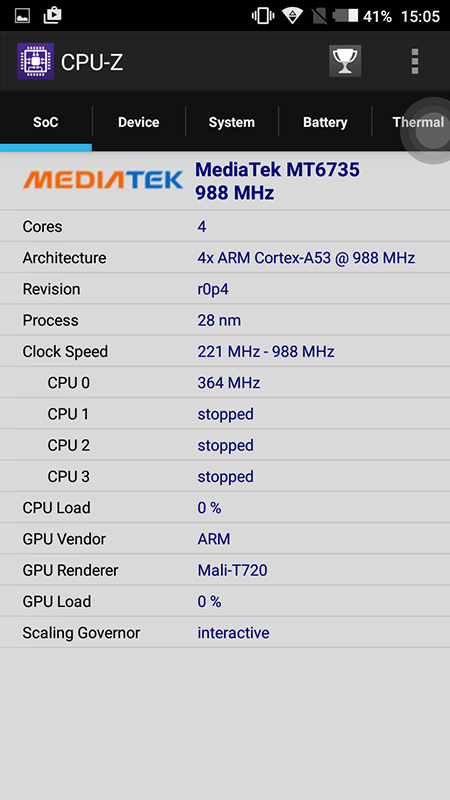

Indeed, Oukitel K10000 can not be called fast. In the Android interface, there are friezes, unlocking with gestures slows down (I already mentioned this), and the levels in Asphalt 8 are loaded for several seconds longer than on innos D6000. It is curious that this toy allows you to choose the maximum graphics level on the Oukitel K10000, but after a detailed comparison it turns out that it is inferior to the picture displayed on the innos D6000 screen. Admire the comparison on the screenshots:

From above - innos D6000, from below - Oukitel K10000. The latter has a "ladder", the first - no
As for the memory size, in innos D6000 its 32 GB, and in Oukitel K10000 - 16 GB. You can put a MicroSD with a capacity of up to 32 GB in any of the smartphones, but in the first case, I remind you, there is a separate slot for the flash drive, but the second one will have to sacrifice one of the SIMs for its installation.
The short verdict is this: in the case of Oukitel, no one thought out anything. What was - and set. And at the same time, and most likely, the MT6735P in the purchase is slightly cheaper than the MT6735M / MT6735.
By the way, one more difference between the usual MT6735 and MT6735P is the lack of support for the GLONASS latest chipset. Although, however, with him and with GPS everything is quite difficult. Because satellites are searched for a long time, and in the end they are about three times less than in the case of innos D6000. The minimum number of satellites required for navigation (four) innos found in general in 10 seconds, while the Oukitel K10000 spent about a minute on this. Draw conclusions. In general, MediaTek chipsets are never strong in the field of navigation, and even if they fall into the wrong hands ... I mean, some LG company also uses MediaTek solutions in a number of its devices, but completes them in such a way that GPS does not raise any questions. But in the case of Oukitel K10000 they are.


On the left - Oukitel K10000, on the right - innos D6000
Wi-Fi (802.11n, 2.4 GHz) in both cases works quite well, although there were some nuances here too. For example, when I get in the elevator on my landing, the innos D6000 still sees the home network, but the Oukitel K10000 loses it after the metal door of the vestibule is closed. Bluetooth works fine on that and on another device, there are no questions here.
Cellular network both smartphones catch normally. Both the Oukitel K10000 and innos D6000 support LTE Cat. 4 (up to 150 Mbit / s), but the first is “friendly” with only band 1, 3, 7 and 20, and the second with 38 and 40. The latter are used by a number of operators in Moscow, and they will not be superfluous. As for the quality of voice transmission, I already spoke about it above - you can comfortably talk on both smartphones, but innos D6000 wins due to two microphones and a noise cancellation system.
Before proceeding to the description of your impressions of the software, here are some screenshots from the Oukitel K10000. And I will add that once, after a reboot, for some reason, he spontaneously switched from Russian to Ukrainian - I don’t know how to explain this love of his spryvuyi.


In short, glitches in the Oukitel K10000 are available. And some of them are very unpleasant - in particular, sometimes the Play Market closes with an error when you try to specify the name of an application in the search. This is very often found on budget Chinese tablets. I was also surprised by the incompatibility of the smartphone with Adobe Photoshop Touch - I often use this editor on innos D6000 and my other devices. I do not know who to blame for this joint. Whether MediaTek, or Oukitel.

Innos D6000 doesn’t have anything like it - but there is a stable and polished firmware, updates for which are released on average once a month. For example, the latest software version from the end of May 2016 takes into account 18 wishes of the device users - so you can write your aspirations in the comments, they are monitored. Now the software for innos D6000 is based on Android 5.1.1 Lollipop, and by the end of the summer there will be a firmware from Android 6.0 Marshmallow.

The latest firmware changer for innos D6000: 6 points, and all important
For comparison: the Oukitel K10000 is still running Android 5.1 (that is, without a set of bug fixes and patches added in 5.1.1), but will there be an update to 6.0? news. But I should note that minor updates for the smartphone are periodically released, this is what I flew in:
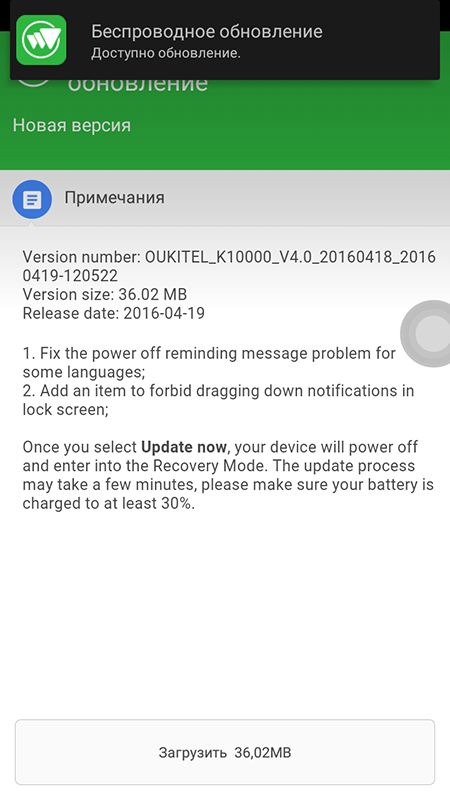
The latest firmware changer for the Oukitel K10000: 2 points, and both - well, just great.
The Android interface in the Oukitel K10000 is rewritten - well, that is, a typical Chinese launcher is used a la iOS without the main menu (icons are on the desktops) two to choose from, others can not be downloaded and put), with a bunch of tripe related to gestures / movements control, as well as a “floating” button to access a number of functions. It looks like this:
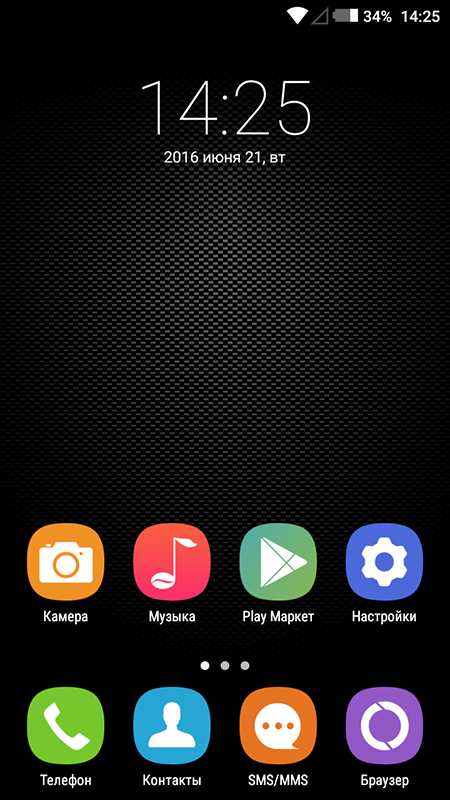

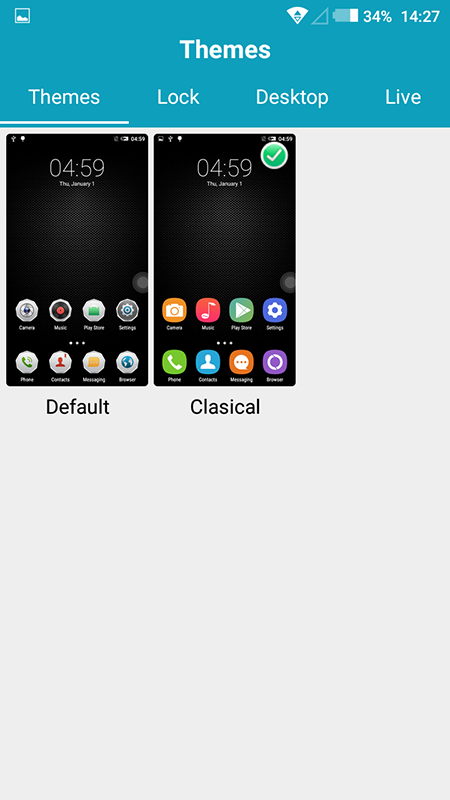
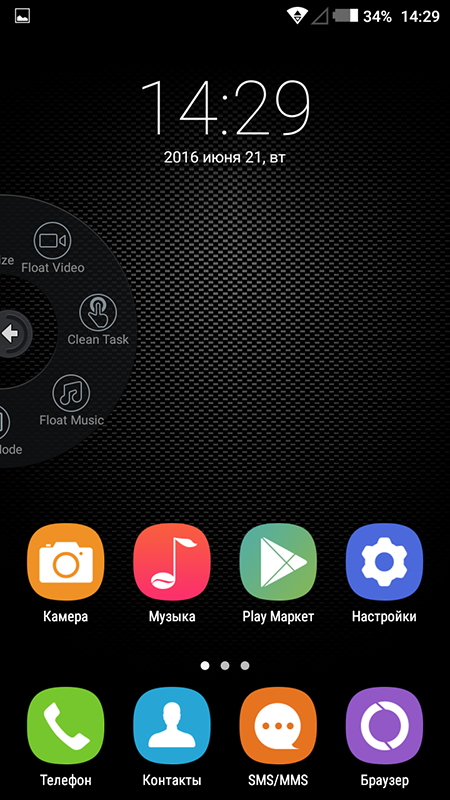
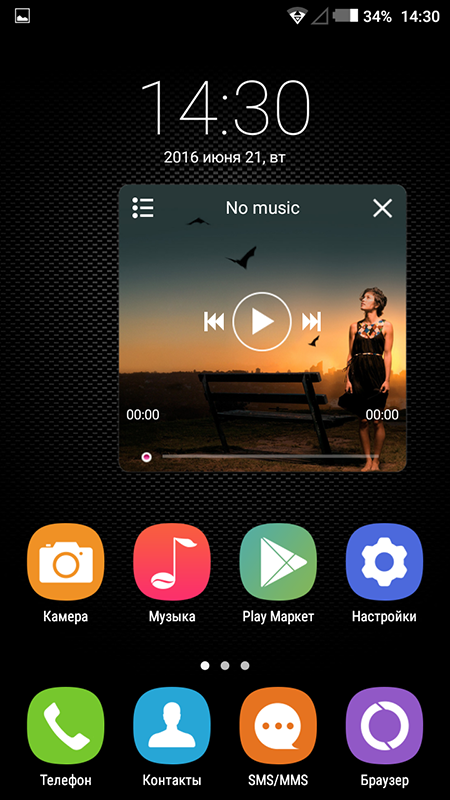
I can not say that I am delighted with the shell - well, typical China is not in the best sense of the word (that is, not MIUI, not Flyme, and not even Vibe UI), coarse, without really useful innovations and so on. The interface is partially translated into Russian - for example, everything related to this very control of gestures and movements is in English. It's good that there are no hieroglyphs ...

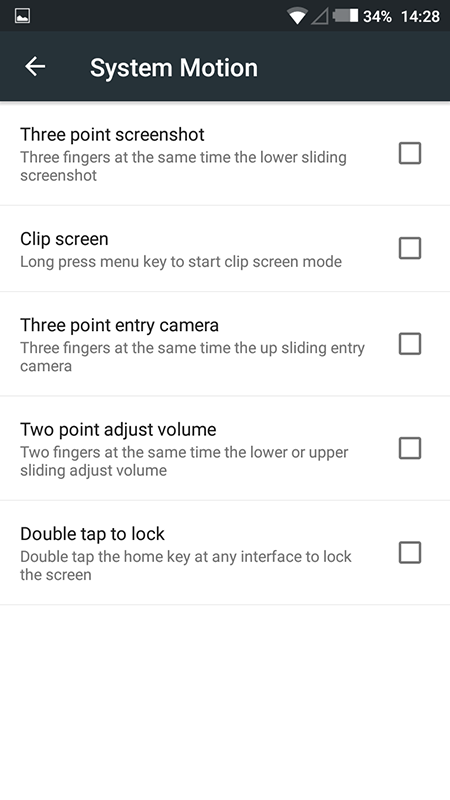
innos D6000 contrasts all this with almost pure Android with a number of useful points, such as a voice recorder for recording telephone conversations and the ability to add functions to Android's software control keys - those that are displayed. With the transfer to the great and mighty, there are no problems here, all the firmware is Russified, and quite qualitatively.




Total: Oukitel K10000 is a Chinese smartphone, which was not prepared for appearance on the Russian market (the device comes “gray”), and the firmware was sculpted according to the Chinese principle: crammed everything, and how it looks and works normally - this is allowed by the user understands. innos D6000 is also a Chinese smartphone, but it was thoroughly prepared for its arrival in Russia. And caring people .
Cameras
Both devices use modules from the American OmniVision, only the innos D6000 has a resolution of 16 megapixels, and the Oukitel K10000 - 13. Photo quality, in my opinion, is comparable: something turns out better with the first, something with the second. I will give a few examples of photographs, and let the readers make the conclusions - that someone likes more.
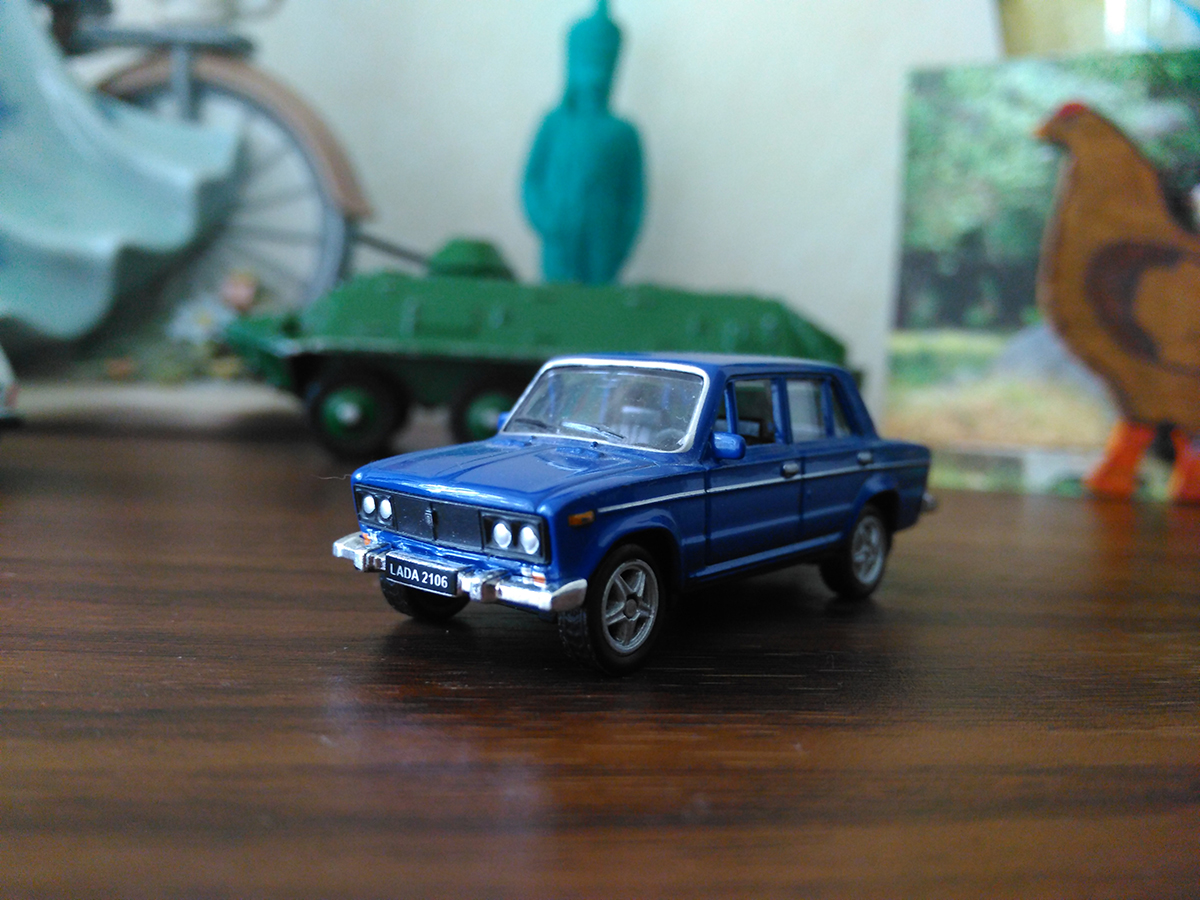
Frame with innos D6000

frame with Oukitel K10000
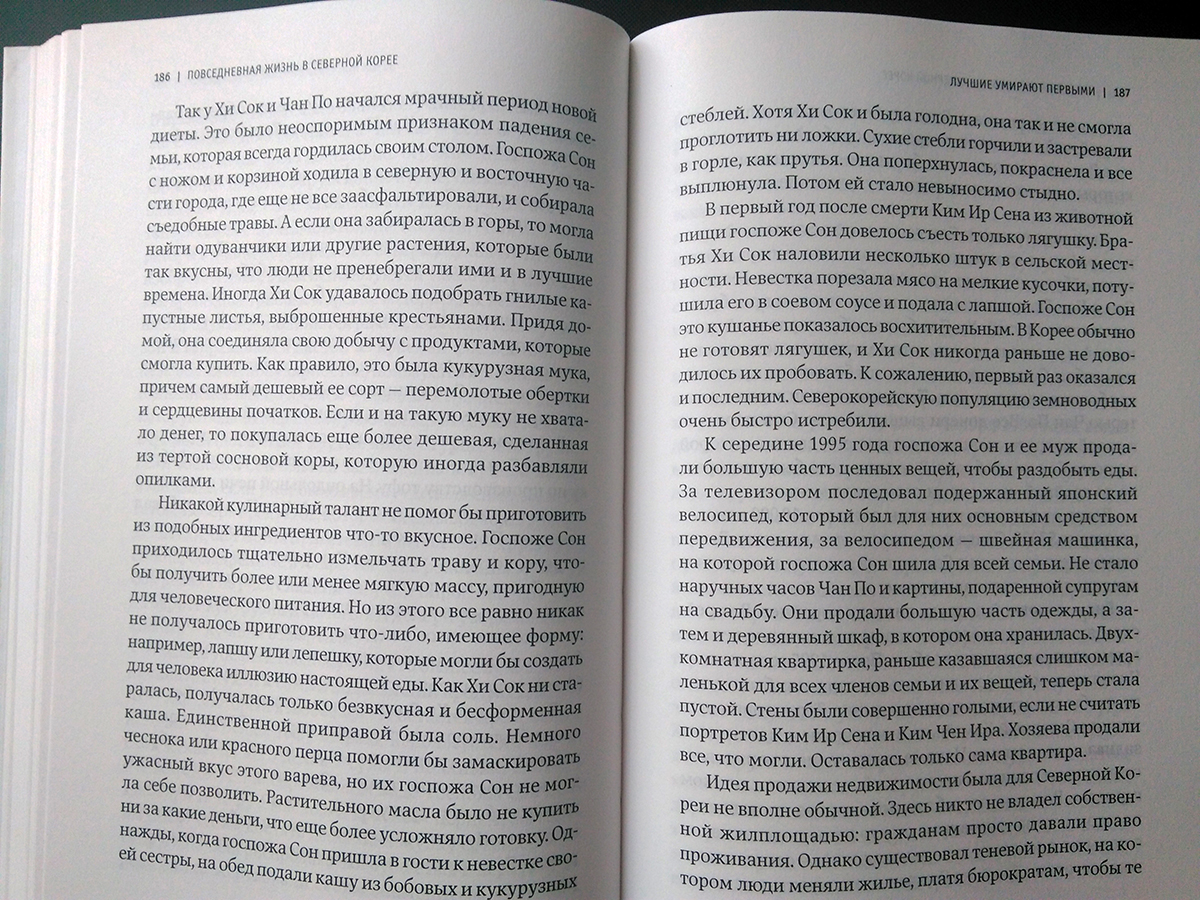
frame with innos D6000
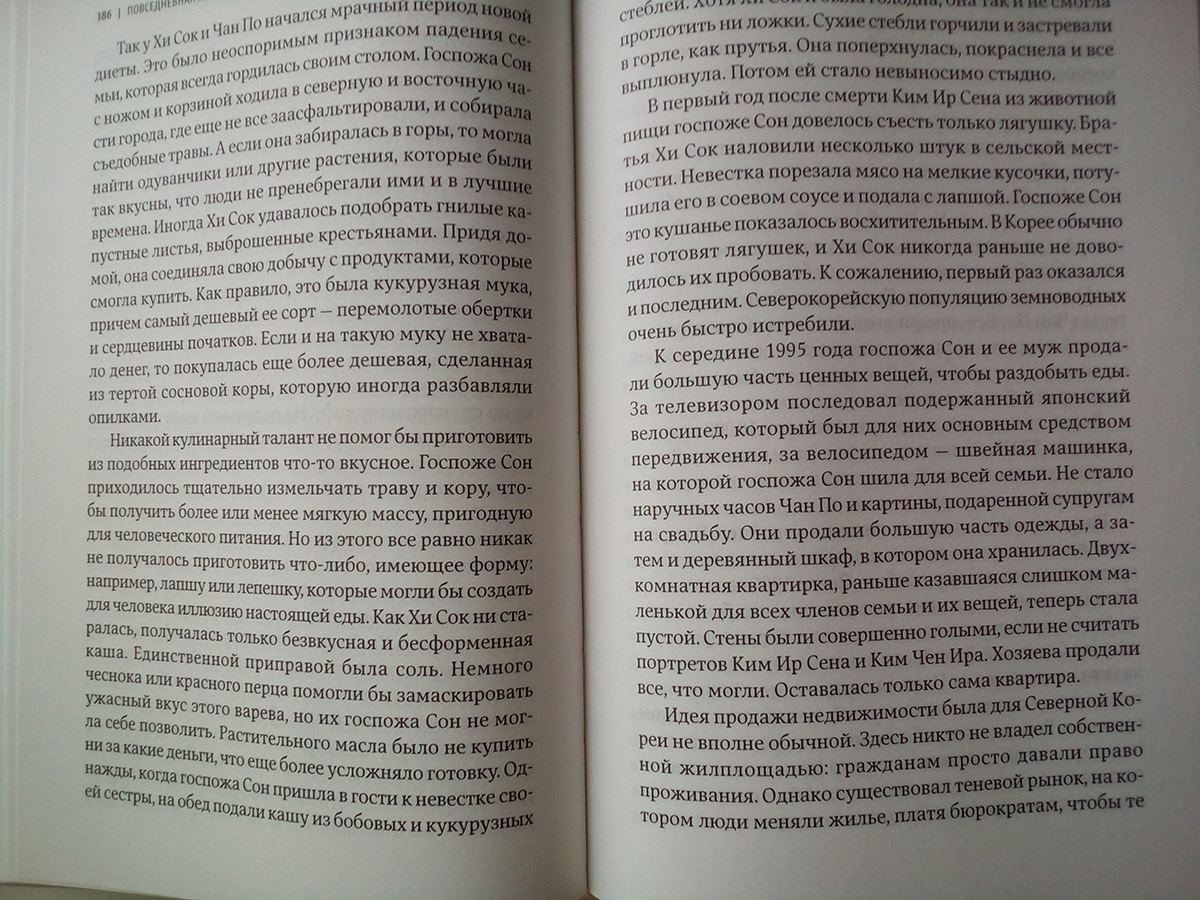
frame with Oukitel K10000
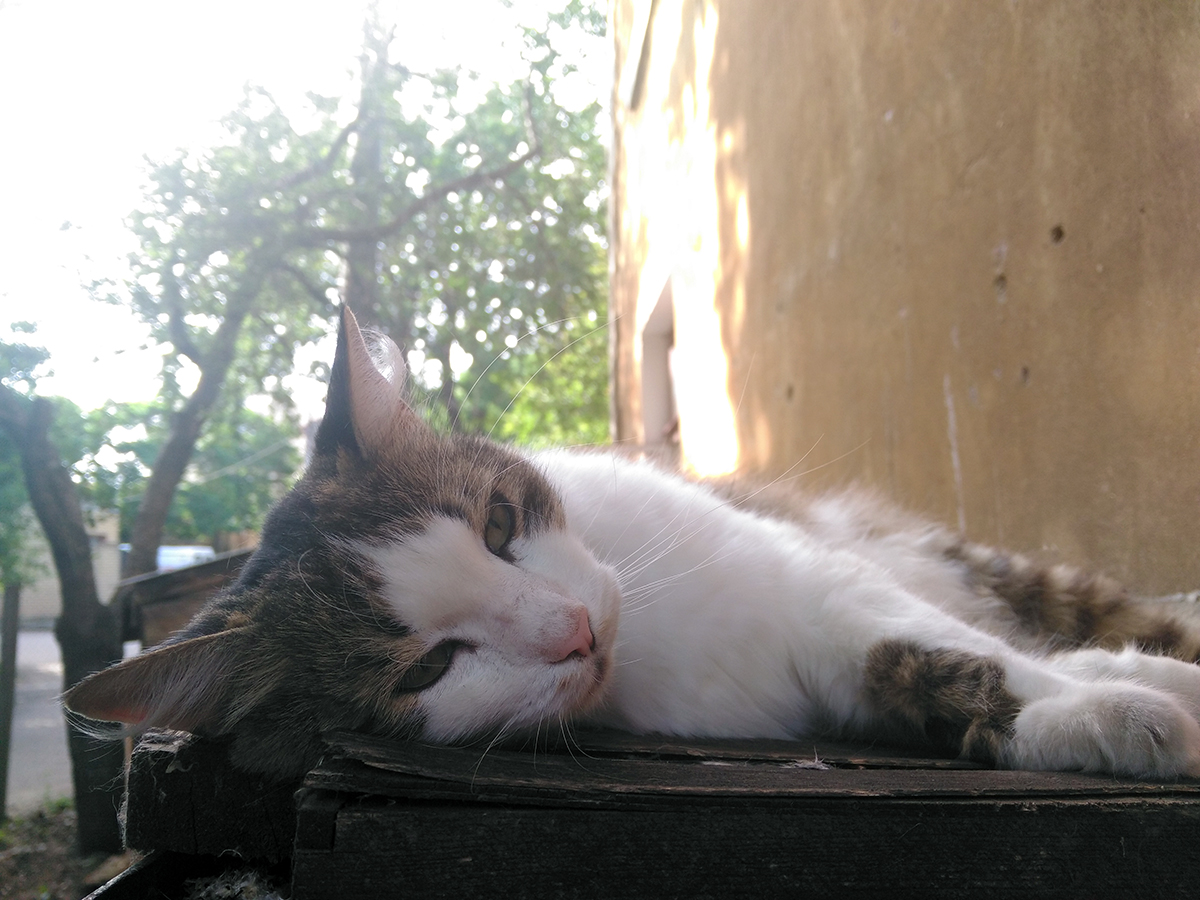
frame with innos D6000

frame with Oukitel K10000

frame with innos D6000

frame with Oukitel K10000

frame with innos D6000

frame with Oukitel K10000

frame with innos D6000

frame with Oukitel K10000

frame with innos D6000

Frame with Oukitel K10000
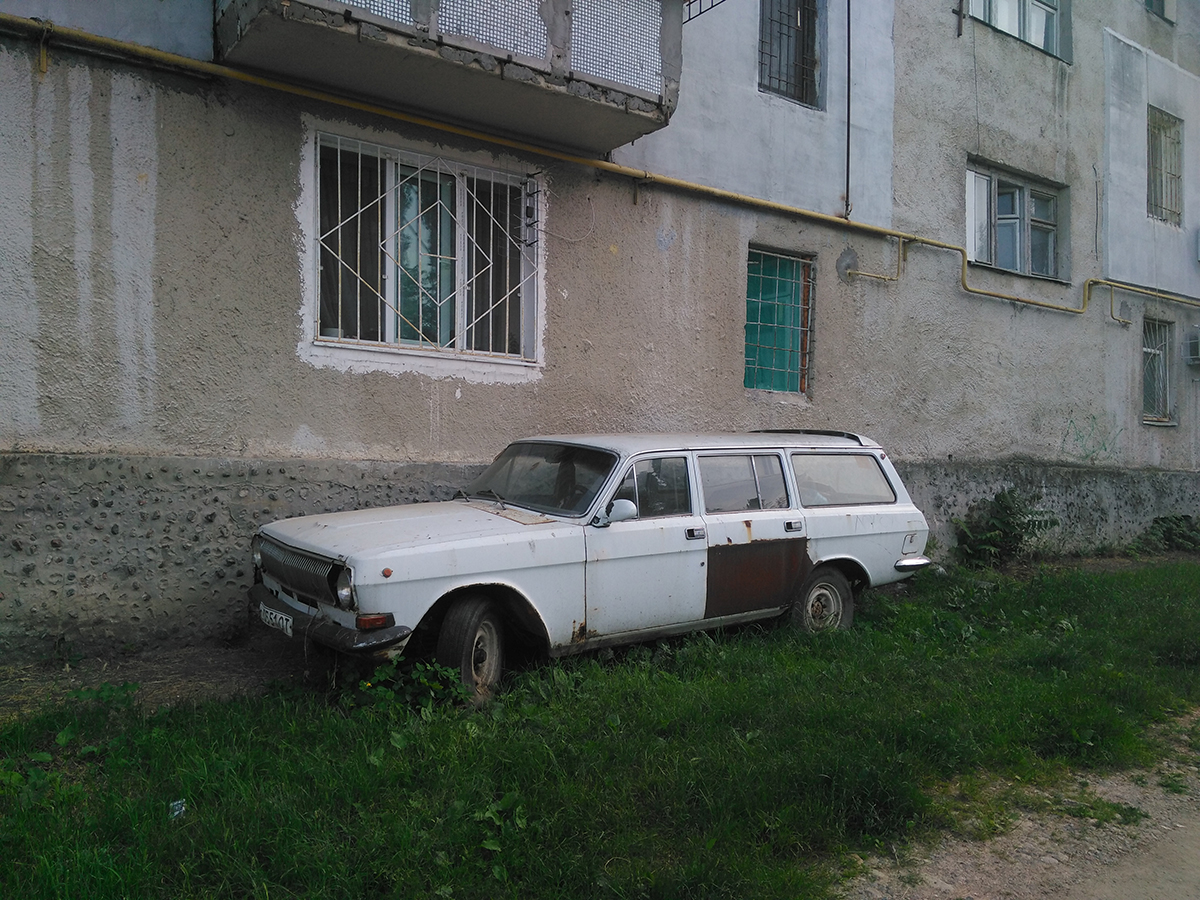
Frame with innos D6000

Frame with Oukitel K10000
Video in both cases is recorded in Full HD 1080p resolution. Quality is comparable.
Finally, examples of “self-shooters” on front 5-megapixel cameras.

On the left - a frame with Oukitel K10000, on the right - a frame with innos D6000
The Oukitel K10000 uses a familiar interface for photographing and recording video - the same can be seen in almost any tablet and smartphone on MediaTek hardware.

The innos D6000, in turn, uses the Qualcomm camera interface.
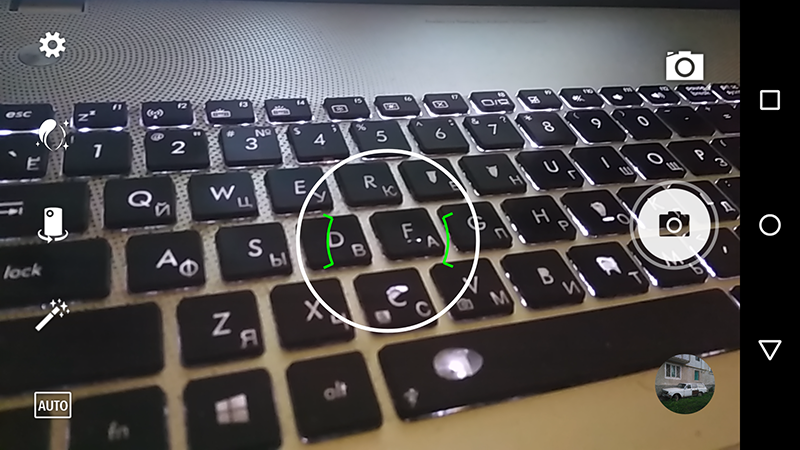
There are enough settings both there and there, and I don’t try to judge which interface is more convenient. Frankly, in both cases there is still something to refine and improve.
6,000 mAh vs. 10,000 mAh - it seems, it is obvious which device will last longer. But not everything is so simple. KAMAZ has a 5-liter engine, but it drives slower than the Ford Focus 1.6. Perhaps the analogy is not 100% correct, and yet. The battery life of a smartphone depends not only stupidly on the capacity of the battery, but also on the mass of other factors. This includes the size of the screen and its resolution, the chipset used, the quality of the firmware optimization, and so on and so forth. Above, I have repeatedly hinted that the Oukitel K10000 was developed almost on the knee - and this, alas, resulted in a very short time for the device with such a powerful power source.

These results Oukitel K10000 - a consequence of the fact that the developers decided to take a weak "autonomous" Android-smartphone with only one powerful battery. More precisely, VERY-VERY powerful. Nobody thought that it would be better to put not 5,5, and 5-inch screen. And the latest generation, which optimized power consumption. Nobody thought that when creating a smartphone with a powerful battery you should not use MediaTek chipset. And if there were no other options, then it was worth taking a chipset that supports the current screen resolution. Because the MT6735P is designed for the qHD format, and in the Oukitel K10000 it has to work with HD, which probably forces the chipset along with the integrated graphics accelerator to constantly plow in an enhanced mode. As a result, the device turned out to be slow, and the main goal (megaavtonomki) could not be achieved. Completing the picture is raw firmware: with the help of a competent optimization, all the above mentioned problems could either be taken away altogether, or at least smoothed out. But the firmware in the Oukitel K10000, I repeat, is far from perfect.
The C innos D6000 situation is completely different. Yes, the Snapdragon 615 with its 8 cores eats a bit more energy than the MT6735P “dohlyak”. However, it is quite pleasant to use the innos smartphone - it does not slow down, the toys start and work normally on it, and the latter are displayed on a high-quality Full HD screen. At the same time, its diagonal is optimally selected - 5.2 inches. More and more convenient than 5, but less than 5.5. What allowed not so much to increase power consumption and not to turn a smartphone into a shovel. Plus, optimized firmware, which is constantly being improved - including in terms of optimizing energy consumption. And if you remember that for 990 rubles for the innos D6000, you can buy another removable battery ... One such battery gives an additional 8 hours when watching a video, 4 hours in games or 2 more days during normal use. But such batteries can be purchased and three, and five, and ten ... and even a hundred! And then change them without turning off the smartphone - the benefit is supported hot-swappable. Well, who else dares to recall the Oukitel K10000 and say that it is ahead of the rest?
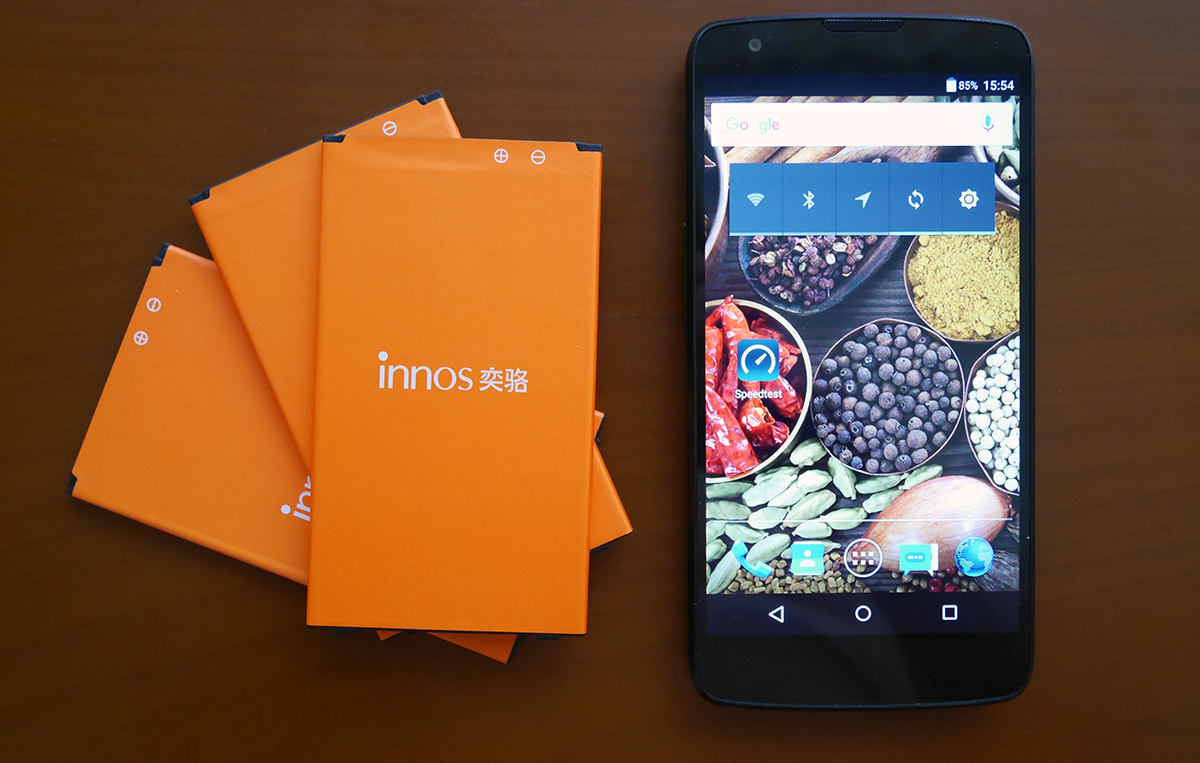
If we talk about the specific features of Oukitel related to autonomous operation, we can note a number of program modes for saving energy. True, these tools can be put from the Play Market on almost any smartphone. I can’t judge the effectiveness of these applications - there is an opinion that they are really useful only when they are deeply integrated with the hardware components of the smartphone and embedded in the software at the development stage, like, say, Samsung. In the case of the Oukitel K10000, they may give them extra battery life for an hour or two, and that’s not a fact.


However, there is in the Oukitel K10000 and a useful "battery" option - the smartphone can be used as an external power bank for other devices. Moreover, the corresponding adapter is included in the package. In innos D6000 this option, alas, no.
Finally - on the charging time. Oukitel K10000 for full "saturation" of the battery will have to keep the outlet about 4 and a half hours, innos D6000 - about 3.
Taking this opportunity, let me remind you of another smartphone, whose battery capacity theoretically approaches 10,000 mAh - this is Highscreen Boost 3 Pro. I already mentioned it in the comparative review of smartphones with powerful batteries, but here I’ll only consolidate what I’ve done so far. The JSR company, owner of the innos brand, developed the Boost, Boost 2 and Boost 2 SE models for Highscreen. But then the collaboration stopped, and JSR has nothing to do with Boost 3 / Boost 3 Pro. Although, we admit honestly, at one time there was an idea to bring innos D6000 to the market under the name Highscreen Boost 3 Pro, but then it was abandoned. It is even more interesting to find out what happened with Highscreen in cooperation with a nameless Chinese factory.

The Highscreen Boost 3 Pro comes with two batteries - 3,000 and 6,000 mAh. Together they can not work. That is, either one or the second. Some people believe that 9,000 mAh is much better than 6,000 mAh for the innos D6000. But let's count. Highscreen Boost 3 Pro costs 21 thousand rubles. Innos D6000 - 16 thousand. Add here one additional battery for 3 520 mAh for 990 rubles from innos.com/ru - and we get 17 thousand rubles and a total capacity of 9 520 mAh. Moreover, removable batteries can be changed without turning off the smartphone, and not work with one or the other, as in the case of Highscreen Boost 3 Pro. But you can also buy from innos D6000 not one battery for 990 rubles, but two, three, five, ten - as many as you like.

In terms of memory (3 GB of RAM + 32 GB of ROM), smartphones are the same; in terms of screen resolution - also (1920 x 1080) in performance - the same. True, MediaTek's chipset is involved in Highscreen, and we already spoke about the love of this company’s platforms for squandering energy in an unknown direction. So it's not entirely clear why the MediaTek solution was chosen for the long-playing smartphone. The camera on the Highscreen Boost 3 Pro is weaker (13 megapixels versus 16 on the innos D6000), the microUSB port versus the USB Type-C on the innos D6000. On the side of the Highscreen solution, there is a high-quality sound in the headphones, which is obtained due to an expensive, isolated audio chip. However, in order to feel this very megaphone, you need to buy headphones that stand at half Boost 3 Pro, or even more.
The innos D6000 has a modest delivery kit: a 2 A charger unit, a USB Type-C cable -> USB orange, and a quick start guide.

In the box with Oukitel K10000 poured a lot of things. I already mentioned some accessories (an adapter and a bent clip for extracting a tray of cards), and here I will add only 2A charging, a MicroUSB cable -> USB with an abnormally long plug, an English manual, another matte film on the screen (one was glued initially, but I took it off because it makes the image soapy) and the bumper is made of thin brittle plastic. I do not recommend using the latter: the smartphone in it becomes even a millimeter over and over, and the reliability of the bumper is such that ... For some reason, I think that I can break it with a strong click.

Oukitel K10000 today you can buy for about 15 thousand rubles - someone can find a little cheaper, and someone is a bit more expensive, it all depends on the greed of a particular online store. Warranty device is not provided, since the company Oukitel sits in China and she, by and large, does not care what will happen to the user of the device in a distant and cold Russia.
Should I buy this device? Probably, yes, if you blindly trust the figures, and your five is about the size of Schwarzenegger or Tyson. Well, if you need a long battery life and a high-quality smartphone, then you shouldn’t buy the magic number “10 000 mAh”. Oukitel K10000 works as much as innos D6000 from its 6,000 mAh. At the same time, the latter is also pleasant to use, it is provided with an official guarantee and you can buy as many removable batteries as you need. The device itself is soldfor 15 990 rubles, and adding to this another battery for 990 rubles, we get 9 520 mAh. Almost as much as the Oukitel K10000, but only the innos D6000 will work on these 9,520 mAh much longer. Because everything in it is thought out to the smallest detail - both in the field of ensuring autonomous work, and in general as a whole. This is especially clearly understood after you come across a Chinese smartphone from a small manufacturer - well, just like Oukitel with its “beautiful” K10000.

Well, you asked - we do. For two weeks I used the Oukitel K10000 and innos D6000 at the same time, the result of which is this comparative review. For the sake of order, let me remind you that we absolutely confidently call the innos D6000 “the most thoughtful long-lived smartphone” - and in this post I will once again explain what is meant by this, so to speak, term. Because in Oukitel they didn’t think of almost anything, but simply took some kind of apparatus - apparently, the developers initially planned to create a Vertu clone - and, in a hurry, inserted the largest battery they could find. What was the result? It turned out, to put it mildly, something strange. But more on that below, but for now - a comparative table:

Appearance and design
Of course, an unprepared user Oukitel K10000 makes a serious impression. As mentioned above, some might think that this is a new Vertu for a few thousand dollars. This is indeed possible, given that there are no inscriptions and logos on the front panel of the device hinting at Oukitel. However, all positive in a moment is destroyed when this very unprepared user picks up a device, for example, off the table. It has 317 (three hundred and seventeen) grams of live weight! And bare slippery metal on the sides! To be honest, such a heavy construction, and even with an unpleasant feature in the form of slipperiness, makes the model unsuitable not only for women, but also for some men. Perhaps some readers have come across so-called protected Android smartphones - like the teXet X-Driver; So, the Oukitel K10000 is even more massive and heavier, although there is no protection here.

The body - and you can’t argue with that - is made to last, the build quality is excellent. Metal panels, however, do not look very cool. Neither the iPhone, nor the Samsung Galaxy will not see such here ... well, color drops, or something. Perhaps this is such a feature (defect?) Of metal processing.
The central part of the back panel bears on itself a black plate - apparently, it is also a thin metal. The logo with the bull looks cool, as well as, by the way, screws, “scattered” throughout the body. In general, the design of the model will not stick to it - he is really quite cute. And brutal.

innos D6000, of course, on the background of the Oukitel K10000 looks inconspicuous. No frills here, just black polycarbonate on the sides and back. The material is rough, so that in the hand innos D6000 is not bad. With its 188 grams of weight, he looks like a feather after the Oukitel K10000. And also innos D6000 is perceived as a rather elegant thing: its thickness is 12 mm versus 14 mm in Oukitel K10000. It would seem a trifle, but when you try to cram a smartphone into your jeans pocket, even 2 mm play a role. Innos D6000 is also assembled perfectly - there are no creaks, the device is monolithic, although it has a collapsible design.
The Oukitel K10000 has inserts from a material that looks like rubber. Ideally, rough tires would be very useful here - after all, the sidewall is slippery! She could "cling" to her hand, helping to hold a smartphone in her. But no, alas, it is not rubber, but such plastic. And quite slippery. So to operate the Oukitel K10000 is really not that simple. And to drop it is scary: if such a metal object is, for example, on a toe, then a trip to the emergency room cannot be avoided.

The same plastic that resembles rubber
Multimedia speakers in both smartphones are located on the bottom of the case, this is convenient, since the sound does not overlap, no matter how the smartphone is lying - even if it is “face on the floor”, on the contrary. The Oukitel K10000 has two speakers, but the sound is rather dirty, so cheap Chinese speakers usually play at 500 rubles each. Innos D6000 has only one speaker, but it “sings” more qualitatively and loudly. At the same time, the volume of percent is 20 higher for the Oukitel K10000.

The Oukitel K10000 uses a microUSB port, and is very heavily recessed into the case. This means that charging it anyhow with what kind of cable will not work - it comes with a cord with a special long plug. That is, it is about 2 mm longer than the cables supplied, for example, with Samsung smartphones. Cords from the latter with the Oukitel K10000 do not work - there is not enough plug length. So if you please use the complete! Reasonableness, versatility, convenience? No, not heard.
This is to the question that innos D6000 uses USB Type-C, which is convenient at least due to its symmetry. Many people like to write in the comments that, they say, "at my work / at my wife / in the car / at home / at the dacha cable with a MicroUSB, and then I have to carry USB Type-C everywhere." First, such a cable can be purchased on innos.com/rufor 590 rubles. Secondly, with the Oukitel K10000, you also have to carry a complete cable, and this will be an archaic and inconvenient MicroUSB, which, you see, is doubly unpleasant.

Cable connectors Oukitel K10000, a conventional microUSB cable (in this case, Samsung) and innos D6000. As you can see, the plug from the Oukitel K10000 is noticeably longer than usual!
The microphone at the Oukitel K10000 is also located on the bottom of the case, and it is only one. Innos D6000 has two microphones - one from the bottom (disguised as a second speaker), the second from the top. Due to this, a noise reduction system is formed - and it really works. In any case, the quality of voice transmission is noticeably higher in the innos D6000. There are no crunches, gurgles, and so on, but they are sometimes found in the Oukitel K10000. In this case, I emphasize that the latter unit also provides a satisfactory communication quality. Simply, it is slightly lower than the innos D6000.
Above the screens are light and proximity sensors, front cameras and conversational speakers. In the innos D6000, an LED indicator is added to this basic set, which notifies of various events (mail, PMs, missed calls) with orange light.

On the upper edges are standard 3.5 mm headphone jacks. The innos D6000 also has the second microphone mentioned above.
The standard Android control keys for the Oukitel K10000 are under the screen, and I have several complaints about them at once. First, I did not like the lack of illumination - in the dark they have to be searched by touch. Secondly, the icons are applied in a very peculiar way, like in many Chinese devices. Namely: the icon, indicating on all modern devices (the same Samsung Galaxy S7, for example, as well as many others) calling the most recently launched applications, in the case of the Oukitel K10000, calls up the context menu of properties, if provided in the application. And the last running ones can be displayed on the screen by pressing the home button. There are no such keys in innos D6000, more precisely, they exist, but in the virtual version - with the display on the screen. Personally, to me, to be honest, my heart is the third option: physical buttons, but with backlighting and normal symbols.

Other control keys are on the right side of the Oukitel K10000 case. Above the round small power button, below - volume control. Before the power key, given the 5.5-inch smartphone form factor, it is very inconvenient to reach for. In part, this problem is solved by the gesture-management application built into the firmware — for example, you can wake up the smartphone by double tapping the screen, unlock it by means of a horizontal pass, turn on the camera from a locked state with a horizontal pass, and so on. Everything would be fine, but this “gesticulation” works rather slowly. Before the action is performed (for example, the screen is unlocked), the smartphone shows an animation that takes a second and a half. Why it is necessary is not entirely clear, but it cannot be disabled.



On the left - a list of gestures, on the right - a screenshot of the animation when unlocking with a horizontal pass.
The innos D6000 is more familiar. Volume control is located on the left, which is, let's say, more traditional. The power button, located on the right, does not have to stretch, the device is noticeably shorter than the Oukitel K10000. At the same time, an additional hardware button is provided in the innos D6000, on which any application can be hung - be it a VKontakte client or a screenshot. In the Camera application, she is always responsible for creating the snapshot. The button does not work when the device is locked (unless it turns on the screen), but still this is a very nice feature found in smartphones extremely rarely.



Application selection interface for the innos D6000 extra key
The back panel of the Oukitel K10000 is non-removable, that is, the device is not collapsible. Slots for "simok" and memory cards are on the side. To remove them is a clip that is included in the package. In my case, it was bent - whether it was an accident, or an indicator of "high" quality ...

However, personally I was not more upset by this, but by the construction of slots combined in a strange Chinese fashion. That is, either nano-SIM + nano-SIM, or nano-SIM + MicroSD. Well, OK, I still understand, when in this way they save space in ultra-thin models, but why did it happen here? With such a huge body? There would be five slots, not to mention three.

Innos D6000 slots are just three - two microSIM and one MicroSD. The back cover is removable, under it there is a removable battery of 3,520 mAh. Another one is built into the case - by 2 480 mAh. It is not visible, it is inside. Total battery capacity - 6,000 mAh. Removable battery can be removed without turning off the smartphone, that is, supported hot swap "on the fly." This is a unique feature of nnos D6000. Hot-swappable without turning off the device no one else has a smartphone in the world.
"External" batteries for innos D6000 can be bought as much as you like at innos.com/ru990 rubles each. Actually, if you buy only one such battery, then we get the total capacity of 9,520 mAh (6,000 + 3,520), which is almost the same as the Oukitel K10000. However, the story of the batteries and battery life will be left for a sweet - we'll talk about all of this below.

Screens
At Oukitel K10000 IPS-screen with a diagonal of 5.5 inches and a resolution of 1280 x 720 pixels. Not enough for such a diagonal, but the problem is not even in the grain of the picture (although it has a place to be). The problem is that it has an air gap between the glass and the matrix, and the backlight does not work evenly - just look at these lights at the bottom of the screen. Cherry on the cake are narrow viewing angles, despite the IPS-matrix, - with the deviation of the device, the image significantly loses contrast.
All this means that the Oukitel K10000 is equipped with a screen of previous generations, which not only shows a very average quality picture, but also has a higher power consumption compared to modern displays. The only advantage of this screen is a large margin of brightness.

Innos D6000, on the other hand, has a completely modern IPS screen from Japan Display with OGS (when there is no air gap) and even backlighting without any spots and other artifacts. The display resolution is 1920 x 1080 pixels with a diagonal of 5.2 inches. It is difficult to say which screen eats more energy, given the different diagonals and resolution. Most likely, they are about the same in this regard. But the fact is that the innos D6000 display displays a much better picture - this also applies to clarity, and viewing angles, and the purity of black, and behavior in the sun.
The sensitivity of the touchscreen is the same - there are no problems with the management of both smartphones. That's just the grease-repellent coating in the Oukitel K10000 is missing, it collects fingerprints quickly enough. Innos model has such coverage, and there are virtually no problems with prints. Yes, here I will add that the screens in both cases are covered with Gorilla Glass 3 glass.
Hardware platforms
The innos D6000 uses a Qualcomm Snapdragon 615 chipset with an 8-core processor. This is a special case of the ARM big.LITTLE architecture - 4 Cortex-A53 cores here can accelerate to 1.5 GHz, and another 4 cores (also Cortex-A53) - to 1.1 GHz. All this works together with 3 GB of RAM LPDDR3. Actually, the reasonableness of innos D6000 lies in the choice of such a chipset. It is sufficient (although not maximally) economical, but at the same time provides a high speed of the device and more than sufficient performance in toys with 3D graphics. The ARM big.LITTLE architecture, again, helps: if the device is not loaded with any specific serious tasks, then inactive cores are disabled for the sake of saving energy. In general, the speed of the innos D6000 there are no complaints - and in any mode, whether it be games or web browsing with a dozen open tabs. I read that some people consider the Snapdragon 615 "not productive enough." I do not know who took this statement and where. Perhaps, someone was “lucky enough” to work with the device, which had a raw firmware. Well, or in his smartphone on the Snapdragon 615 was 1-2 GB of RAM - against 3 GB innos D6000.


Everything is interesting with the Oukitel K10000. The device uses a bundle of 2 GB of LPDDR3 RAM and a MediaTek MT6735P chipset, that is, the simplest version with 4 Cortex-A53 cores (up to 1 GHz) and Mali-T720MP2 graphics accelerating to 400 MHz. MediaTek does not have information about this version of the chipset, but some sourcesreported that her lot - screens with a resolution of 540 x 960 pixels (!). For comparison, the MT6735M with a graphics accelerator frequency of 500 MHz can work with HD displays (1280 x 720), and the MT6735 with a graphics frequency of 600 MHz and 1.3 GHz processing cores with Full HD screens (1920 x 1080) . The Oukitel K10000, as you already know, is worth the MT6735P and ... HD display. That is, this chipset for this resolution is not sharpened, but the developers of the smartphone for some reason chose the version of the platform with the letter “P” in the title. How it can affect the stability and speed of the smartphone, its power consumption, and so on - guess yourself. (Answer: obviously not positive.)


Indeed, Oukitel K10000 can not be called fast. In the Android interface, there are friezes, unlocking with gestures slows down (I already mentioned this), and the levels in Asphalt 8 are loaded for several seconds longer than on innos D6000. It is curious that this toy allows you to choose the maximum graphics level on the Oukitel K10000, but after a detailed comparison it turns out that it is inferior to the picture displayed on the innos D6000 screen. Admire the comparison on the screenshots:

From above - innos D6000, from below - Oukitel K10000. The latter has a "ladder", the first - no
As for the memory size, in innos D6000 its 32 GB, and in Oukitel K10000 - 16 GB. You can put a MicroSD with a capacity of up to 32 GB in any of the smartphones, but in the first case, I remind you, there is a separate slot for the flash drive, but the second one will have to sacrifice one of the SIMs for its installation.
The short verdict is this: in the case of Oukitel, no one thought out anything. What was - and set. And at the same time, and most likely, the MT6735P in the purchase is slightly cheaper than the MT6735M / MT6735.
Connection
By the way, one more difference between the usual MT6735 and MT6735P is the lack of support for the GLONASS latest chipset. Although, however, with him and with GPS everything is quite difficult. Because satellites are searched for a long time, and in the end they are about three times less than in the case of innos D6000. The minimum number of satellites required for navigation (four) innos found in general in 10 seconds, while the Oukitel K10000 spent about a minute on this. Draw conclusions. In general, MediaTek chipsets are never strong in the field of navigation, and even if they fall into the wrong hands ... I mean, some LG company also uses MediaTek solutions in a number of its devices, but completes them in such a way that GPS does not raise any questions. But in the case of Oukitel K10000 they are.


On the left - Oukitel K10000, on the right - innos D6000
Wi-Fi (802.11n, 2.4 GHz) in both cases works quite well, although there were some nuances here too. For example, when I get in the elevator on my landing, the innos D6000 still sees the home network, but the Oukitel K10000 loses it after the metal door of the vestibule is closed. Bluetooth works fine on that and on another device, there are no questions here.
Cellular network both smartphones catch normally. Both the Oukitel K10000 and innos D6000 support LTE Cat. 4 (up to 150 Mbit / s), but the first is “friendly” with only band 1, 3, 7 and 20, and the second with 38 and 40. The latter are used by a number of operators in Moscow, and they will not be superfluous. As for the quality of voice transmission, I already spoke about it above - you can comfortably talk on both smartphones, but innos D6000 wins due to two microphones and a noise cancellation system.
Software
Before proceeding to the description of your impressions of the software, here are some screenshots from the Oukitel K10000. And I will add that once, after a reboot, for some reason, he spontaneously switched from Russian to Ukrainian - I don’t know how to explain this love of his spryvuyi.


In short, glitches in the Oukitel K10000 are available. And some of them are very unpleasant - in particular, sometimes the Play Market closes with an error when you try to specify the name of an application in the search. This is very often found on budget Chinese tablets. I was also surprised by the incompatibility of the smartphone with Adobe Photoshop Touch - I often use this editor on innos D6000 and my other devices. I do not know who to blame for this joint. Whether MediaTek, or Oukitel.

Innos D6000 doesn’t have anything like it - but there is a stable and polished firmware, updates for which are released on average once a month. For example, the latest software version from the end of May 2016 takes into account 18 wishes of the device users - so you can write your aspirations in the comments, they are monitored. Now the software for innos D6000 is based on Android 5.1.1 Lollipop, and by the end of the summer there will be a firmware from Android 6.0 Marshmallow.

The latest firmware changer for innos D6000: 6 points, and all important
For comparison: the Oukitel K10000 is still running Android 5.1 (that is, without a set of bug fixes and patches added in 5.1.1), but will there be an update to 6.0? news. But I should note that minor updates for the smartphone are periodically released, this is what I flew in:

The latest firmware changer for the Oukitel K10000: 2 points, and both - well, just great.
The Android interface in the Oukitel K10000 is rewritten - well, that is, a typical Chinese launcher is used a la iOS without the main menu (icons are on the desktops) two to choose from, others can not be downloaded and put), with a bunch of tripe related to gestures / movements control, as well as a “floating” button to access a number of functions. It looks like this:





I can not say that I am delighted with the shell - well, typical China is not in the best sense of the word (that is, not MIUI, not Flyme, and not even Vibe UI), coarse, without really useful innovations and so on. The interface is partially translated into Russian - for example, everything related to this very control of gestures and movements is in English. It's good that there are no hieroglyphs ...


innos D6000 contrasts all this with almost pure Android with a number of useful points, such as a voice recorder for recording telephone conversations and the ability to add functions to Android's software control keys - those that are displayed. With the transfer to the great and mighty, there are no problems here, all the firmware is Russified, and quite qualitatively.




Total: Oukitel K10000 is a Chinese smartphone, which was not prepared for appearance on the Russian market (the device comes “gray”), and the firmware was sculpted according to the Chinese principle: crammed everything, and how it looks and works normally - this is allowed by the user understands. innos D6000 is also a Chinese smartphone, but it was thoroughly prepared for its arrival in Russia. And caring people .
Cameras
Both devices use modules from the American OmniVision, only the innos D6000 has a resolution of 16 megapixels, and the Oukitel K10000 - 13. Photo quality, in my opinion, is comparable: something turns out better with the first, something with the second. I will give a few examples of photographs, and let the readers make the conclusions - that someone likes more.

Frame with innos D6000

frame with Oukitel K10000

frame with innos D6000

frame with Oukitel K10000

frame with innos D6000

frame with Oukitel K10000

frame with innos D6000

frame with Oukitel K10000

frame with innos D6000

frame with Oukitel K10000

frame with innos D6000

frame with Oukitel K10000

frame with innos D6000

Frame with Oukitel K10000

Frame with innos D6000

Frame with Oukitel K10000
Video in both cases is recorded in Full HD 1080p resolution. Quality is comparable.
Finally, examples of “self-shooters” on front 5-megapixel cameras.

On the left - a frame with Oukitel K10000, on the right - a frame with innos D6000
The Oukitel K10000 uses a familiar interface for photographing and recording video - the same can be seen in almost any tablet and smartphone on MediaTek hardware.

The innos D6000, in turn, uses the Qualcomm camera interface.

There are enough settings both there and there, and I don’t try to judge which interface is more convenient. Frankly, in both cases there is still something to refine and improve.
The most interesting: battery life
6,000 mAh vs. 10,000 mAh - it seems, it is obvious which device will last longer. But not everything is so simple. KAMAZ has a 5-liter engine, but it drives slower than the Ford Focus 1.6. Perhaps the analogy is not 100% correct, and yet. The battery life of a smartphone depends not only stupidly on the capacity of the battery, but also on the mass of other factors. This includes the size of the screen and its resolution, the chipset used, the quality of the firmware optimization, and so on and so forth. Above, I have repeatedly hinted that the Oukitel K10000 was developed almost on the knee - and this, alas, resulted in a very short time for the device with such a powerful power source.

These results Oukitel K10000 - a consequence of the fact that the developers decided to take a weak "autonomous" Android-smartphone with only one powerful battery. More precisely, VERY-VERY powerful. Nobody thought that it would be better to put not 5,5, and 5-inch screen. And the latest generation, which optimized power consumption. Nobody thought that when creating a smartphone with a powerful battery you should not use MediaTek chipset. And if there were no other options, then it was worth taking a chipset that supports the current screen resolution. Because the MT6735P is designed for the qHD format, and in the Oukitel K10000 it has to work with HD, which probably forces the chipset along with the integrated graphics accelerator to constantly plow in an enhanced mode. As a result, the device turned out to be slow, and the main goal (megaavtonomki) could not be achieved. Completing the picture is raw firmware: with the help of a competent optimization, all the above mentioned problems could either be taken away altogether, or at least smoothed out. But the firmware in the Oukitel K10000, I repeat, is far from perfect.
The C innos D6000 situation is completely different. Yes, the Snapdragon 615 with its 8 cores eats a bit more energy than the MT6735P “dohlyak”. However, it is quite pleasant to use the innos smartphone - it does not slow down, the toys start and work normally on it, and the latter are displayed on a high-quality Full HD screen. At the same time, its diagonal is optimally selected - 5.2 inches. More and more convenient than 5, but less than 5.5. What allowed not so much to increase power consumption and not to turn a smartphone into a shovel. Plus, optimized firmware, which is constantly being improved - including in terms of optimizing energy consumption. And if you remember that for 990 rubles for the innos D6000, you can buy another removable battery ... One such battery gives an additional 8 hours when watching a video, 4 hours in games or 2 more days during normal use. But such batteries can be purchased and three, and five, and ten ... and even a hundred! And then change them without turning off the smartphone - the benefit is supported hot-swappable. Well, who else dares to recall the Oukitel K10000 and say that it is ahead of the rest?

If we talk about the specific features of Oukitel related to autonomous operation, we can note a number of program modes for saving energy. True, these tools can be put from the Play Market on almost any smartphone. I can’t judge the effectiveness of these applications - there is an opinion that they are really useful only when they are deeply integrated with the hardware components of the smartphone and embedded in the software at the development stage, like, say, Samsung. In the case of the Oukitel K10000, they may give them extra battery life for an hour or two, and that’s not a fact.


However, there is in the Oukitel K10000 and a useful "battery" option - the smartphone can be used as an external power bank for other devices. Moreover, the corresponding adapter is included in the package. In innos D6000 this option, alas, no.
Finally - on the charging time. Oukitel K10000 for full "saturation" of the battery will have to keep the outlet about 4 and a half hours, innos D6000 - about 3.
And one more small comparison
Taking this opportunity, let me remind you of another smartphone, whose battery capacity theoretically approaches 10,000 mAh - this is Highscreen Boost 3 Pro. I already mentioned it in the comparative review of smartphones with powerful batteries, but here I’ll only consolidate what I’ve done so far. The JSR company, owner of the innos brand, developed the Boost, Boost 2 and Boost 2 SE models for Highscreen. But then the collaboration stopped, and JSR has nothing to do with Boost 3 / Boost 3 Pro. Although, we admit honestly, at one time there was an idea to bring innos D6000 to the market under the name Highscreen Boost 3 Pro, but then it was abandoned. It is even more interesting to find out what happened with Highscreen in cooperation with a nameless Chinese factory.

The Highscreen Boost 3 Pro comes with two batteries - 3,000 and 6,000 mAh. Together they can not work. That is, either one or the second. Some people believe that 9,000 mAh is much better than 6,000 mAh for the innos D6000. But let's count. Highscreen Boost 3 Pro costs 21 thousand rubles. Innos D6000 - 16 thousand. Add here one additional battery for 3 520 mAh for 990 rubles from innos.com/ru - and we get 17 thousand rubles and a total capacity of 9 520 mAh. Moreover, removable batteries can be changed without turning off the smartphone, and not work with one or the other, as in the case of Highscreen Boost 3 Pro. But you can also buy from innos D6000 not one battery for 990 rubles, but two, three, five, ten - as many as you like.

In terms of memory (3 GB of RAM + 32 GB of ROM), smartphones are the same; in terms of screen resolution - also (1920 x 1080) in performance - the same. True, MediaTek's chipset is involved in Highscreen, and we already spoke about the love of this company’s platforms for squandering energy in an unknown direction. So it's not entirely clear why the MediaTek solution was chosen for the long-playing smartphone. The camera on the Highscreen Boost 3 Pro is weaker (13 megapixels versus 16 on the innos D6000), the microUSB port versus the USB Type-C on the innos D6000. On the side of the Highscreen solution, there is a high-quality sound in the headphones, which is obtained due to an expensive, isolated audio chip. However, in order to feel this very megaphone, you need to buy headphones that stand at half Boost 3 Pro, or even more.
Equipment
The innos D6000 has a modest delivery kit: a 2 A charger unit, a USB Type-C cable -> USB orange, and a quick start guide.

In the box with Oukitel K10000 poured a lot of things. I already mentioned some accessories (an adapter and a bent clip for extracting a tray of cards), and here I will add only 2A charging, a MicroUSB cable -> USB with an abnormally long plug, an English manual, another matte film on the screen (one was glued initially, but I took it off because it makes the image soapy) and the bumper is made of thin brittle plastic. I do not recommend using the latter: the smartphone in it becomes even a millimeter over and over, and the reliability of the bumper is such that ... For some reason, I think that I can break it with a strong click.

Summarize
Oukitel K10000 today you can buy for about 15 thousand rubles - someone can find a little cheaper, and someone is a bit more expensive, it all depends on the greed of a particular online store. Warranty device is not provided, since the company Oukitel sits in China and she, by and large, does not care what will happen to the user of the device in a distant and cold Russia.
Should I buy this device? Probably, yes, if you blindly trust the figures, and your five is about the size of Schwarzenegger or Tyson. Well, if you need a long battery life and a high-quality smartphone, then you shouldn’t buy the magic number “10 000 mAh”. Oukitel K10000 works as much as innos D6000 from its 6,000 mAh. At the same time, the latter is also pleasant to use, it is provided with an official guarantee and you can buy as many removable batteries as you need. The device itself is soldfor 15 990 rubles, and adding to this another battery for 990 rubles, we get 9 520 mAh. Almost as much as the Oukitel K10000, but only the innos D6000 will work on these 9,520 mAh much longer. Because everything in it is thought out to the smallest detail - both in the field of ensuring autonomous work, and in general as a whole. This is especially clearly understood after you come across a Chinese smartphone from a small manufacturer - well, just like Oukitel with its “beautiful” K10000.
